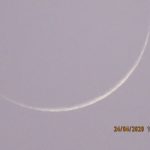
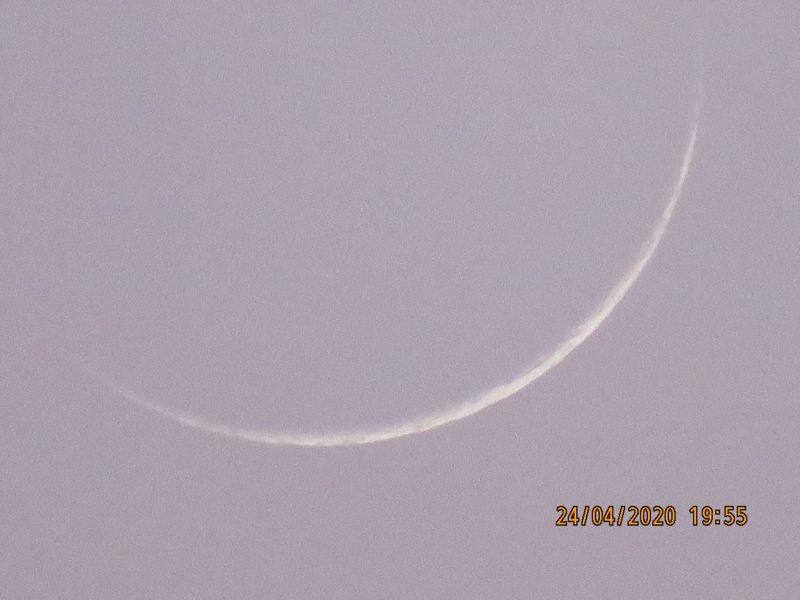
View at EarthSky Community Photos. | Mohamed Mohamed of Tripoli, Libya, captured a young moon on April 24, 2020. Thank you, Mohamed!
New moon – when the moon will be most nearly between the Earth and sun for this month – will come early in the day on April 12, 2021. That means you have an opportunity to spot an exceedingly young moon that evening. For those in central North America and further east, the moon will be less than 24 hours old: a great sky-watching challenge and a satisfying feat if you accomplish it. West of there, the moon will be older, and so easier to see, but still very beautiful. Not many people have seen a moon within a day of new phase. At such times, the moon is still close to the sun along our line of sight, and its lighted portion is turned nearly entirely away from us. Whether you’ll see the moon on April 12 will depend on where you are on Earth’s globe, and on your sky conditions.
Consider that new moon is April 12 at 02:31 UTC, which converts to April 11 at 9:31 p.m. in Central Daylight time in North America. If you’re in that central region of North America, note the time of your sunset on April 11 and 12. It’ll be before 9:31 p.m. Hence, the moon won’t be new yet at your April 11 sunset; it won’t be in the evening sky. But – on April 12 – the moon will be less than 24 hours old, that is, less than 24 hours past the time of new moon. On April 12, as seen from central North America, the moon will have just gotten enough separation from the sun that you might spot the sliver of a crescent in sunset’s afterglow. The times will change depending on your exact latitude and longitude, but you’ll surely have no more than about 40 minutes between sunset and moonset.
In eastern North America and South America, you’ll need binoculars or other optical aid to spot the moon on April 12. But the payoff will be bigger: an exceedingly young moon, much less than 24 hours old. No matter where you are, remember to wait until the sun has completely set before scanning the horizon with optical aid! You’ll also need a flat, clear horizon to the west. Start looking shortly after the sun disappears – when bright twilight still fills the western sky – for the infant moon that’s barely illuminated!
Will you see the young moon from western Europe or Africa? Well … we’ve been surprised before at people’s ability to catch young moons! Let’s just say it will be very difficult.
Those farthest west of the International Date line on April 12 – in other words, in western North America and islands in the Pacific – will have the easiest time spotting the young moon. For them, the very thin crescent after sunset will likely be visible with the eye alone. From those westernmost regions, the moon will have aged, getting farther from the sun along our line of sight, and showing us more of its lighted portion. That’s why the moon will be easier to see from there.
For those who are really eagle-eyed, note that the brightest planet – Venus – is now officially in the west after sunset, too. Venus will be shining at magnitude -3.9 between the setting sun and young moon, but it will be below the horizon within about 20 minutes of the sun’s disappearance. Will you see it? Probably not, but it’s worth a try! And some might pick it up with photographic equipment.
Young moons are located some distance east of the sun on the sky’s dome (because the moon always moves eastward in orbit). Young moons appear to our eye as exceedingly slim crescents, likely illuminated by earthshine, seen low in the western sky for a brief interval after sunset.
What is the youngest moon you can see? More about that below.
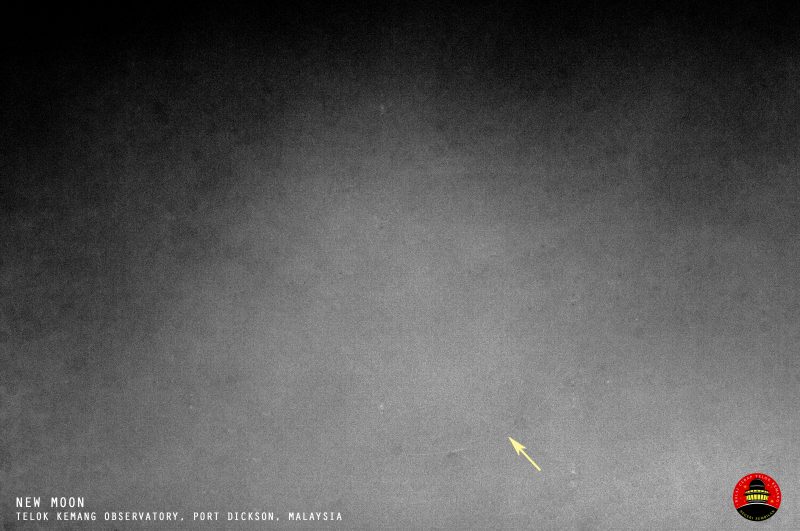
View larger. | We received the photo above from Sarah Nordin. It’s a very unusual photo of an extremely young moon – caught only 15 hours, 19 minutes after the instant of new moon – in daylight, on November 8, 2018. Be sure to click in and view it larger to appreciate it. Sarah caught this moon at Telok Kemang Observatory in Port Dickson, Malaysia. Camera: Nikon D300s. Telescope: Takahashi TOA-150. Camera setting: ISO160_1/640s_RAW file. Congratulations, Sarah!
What’s the youngest moon it’s possible to see?
It’s rare to see a moon within about 24 hours of the new phase. But it turns out, if you use optical aid, you can see the moon all the way until the moment of new moon.
On July 8, 2013, a new record was set for the youngest moon ever photographed (see photos on this page). Thierry Legault – shooting from in Elancourt, France (a suburb of Paris) – captured the July 2013 moon at the precise instant it was new, or most nearly between the Earth and sun for this lunar orbit. Legault’s image (below) shows the thinnest of lunar crescents, in full daylight (naturally, since a new moon is always near the sun in the sky), at 07:14 UTC on July 8, 2013. Legault said on his website:
It is the youngest possible crescent, the age of the moon at this instant being exactly zero. Celestial north is up in the image, as well as the sun. The irregularities and discontinuities are caused by the relief at the edge of the lunar disk (mountains, craters).
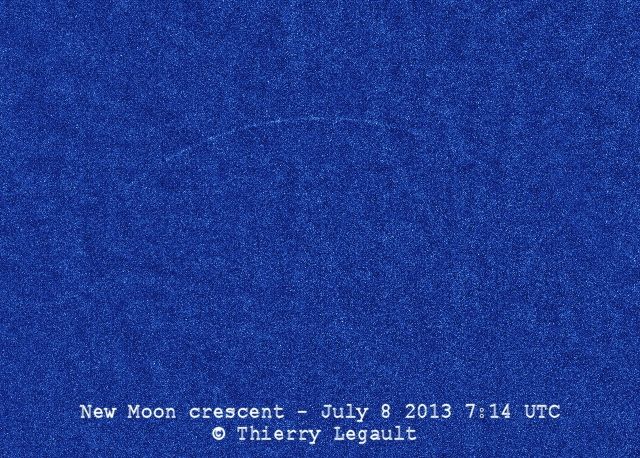
Youngest lunar crescent, with the moon’s age being exactly zero when this photo was taken – at the precise moment of the new moon – at 07:14 UTC on July 8, 2013. Image by Thierry Legault. Visit his website. Used with permission.
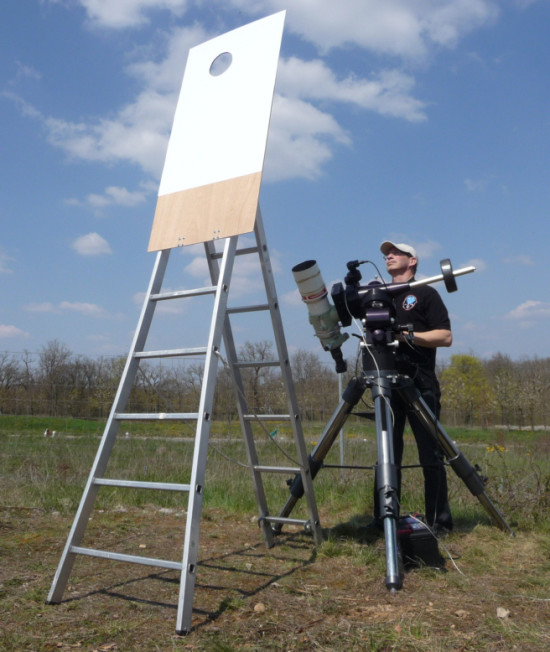
Here is Thierry Legault and his setup for capturing the youngest possible moon. See more photos and read more on his website.
What’s the youngest moon you’re likely to see with your eye alone?
How young a moon you can expect to see with your eye depends on the time of year and on sky conditions. It’s possible to see the youngest moons – the thinnest crescents, nearest the sunset – around the spring equinox.
When Legault captured the image above, the sun and moon were separated only 4.4 degrees – about 9 solar diameters – on the sky’s dome. It is extremely difficult, and risky, to try to capture the moon at such a time. Not only is the sight of our companion world drowned in bright sunlight, but there is also a risk of unintentionally glimpsing the sun and thereby damaging your eyesight.
That’s why Legault used a special photographic setup to capture this youngest possible moon. He wrote:
In order to reduce the glare, the images have been taken in close infrared and a pierced screen, placed just in front of the telescope, prevents the sunlight from entering directly in the telescope.
A longstanding, though somewhat doubtful, record for youngest moon seen with the eye was held by two British housemaids, said to have seen the moon 14 3/4 hours after new moon in the year 1916.
A more reliable record was achieved by Stephen James O’Meara in May 1990; he saw the young crescent with the unaided eye 15 hours and 32 minutes after new moon. The record for youngest moon spotted with the eye using an optical aid passed to Mohsen Mirsaeed in 2002, who saw the moon 11 hours and 40 minutes after new moon.
Wow!
And, of course, optical aid enhances your young moon possibilities even more.
But Legault’s photograph at the instant of new moon? That record can only be duplicated, not surpassed.
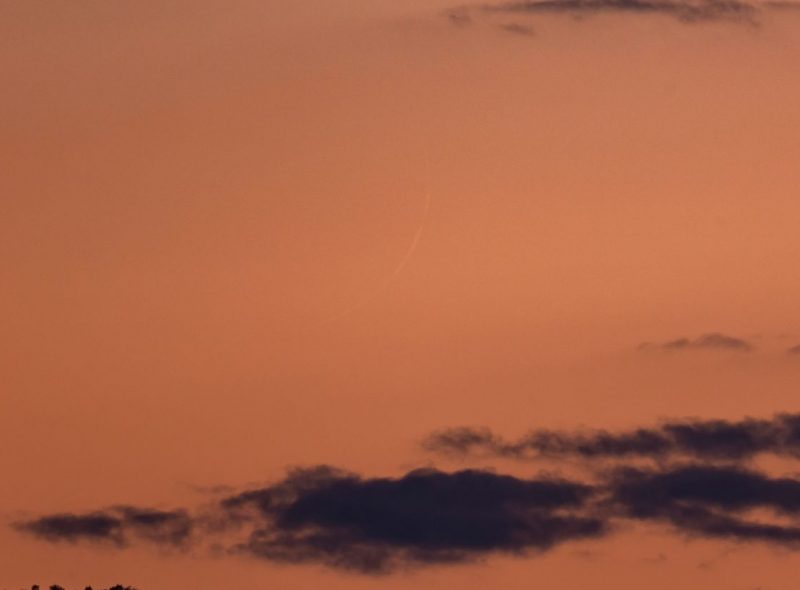
View at EarthSky Community Photos. | Radu Anghel captured the thread-like young crescent moon from Bacau, Romania, on October 17, 2020. Radu wrote: “A very young moon, only 20 hours old. Easy and wonderful to spot even with binoculars, 20 min after the sunset.” Thank you, Radu.
Bottom line: You can try to see a moon younger than 24 hours old on April 12, 2021, just after sunset.
Click here to check out Thierry Legault’s book on astrophotography.
from EarthSky https://ift.tt/327ti6e


View at EarthSky Community Photos. | Mohamed Mohamed of Tripoli, Libya, captured a young moon on April 24, 2020. Thank you, Mohamed!
New moon – when the moon will be most nearly between the Earth and sun for this month – will come early in the day on April 12, 2021. That means you have an opportunity to spot an exceedingly young moon that evening. For those in central North America and further east, the moon will be less than 24 hours old: a great sky-watching challenge and a satisfying feat if you accomplish it. West of there, the moon will be older, and so easier to see, but still very beautiful. Not many people have seen a moon within a day of new phase. At such times, the moon is still close to the sun along our line of sight, and its lighted portion is turned nearly entirely away from us. Whether you’ll see the moon on April 12 will depend on where you are on Earth’s globe, and on your sky conditions.
Consider that new moon is April 12 at 02:31 UTC, which converts to April 11 at 9:31 p.m. in Central Daylight time in North America. If you’re in that central region of North America, note the time of your sunset on April 11 and 12. It’ll be before 9:31 p.m. Hence, the moon won’t be new yet at your April 11 sunset; it won’t be in the evening sky. But – on April 12 – the moon will be less than 24 hours old, that is, less than 24 hours past the time of new moon. On April 12, as seen from central North America, the moon will have just gotten enough separation from the sun that you might spot the sliver of a crescent in sunset’s afterglow. The times will change depending on your exact latitude and longitude, but you’ll surely have no more than about 40 minutes between sunset and moonset.
In eastern North America and South America, you’ll need binoculars or other optical aid to spot the moon on April 12. But the payoff will be bigger: an exceedingly young moon, much less than 24 hours old. No matter where you are, remember to wait until the sun has completely set before scanning the horizon with optical aid! You’ll also need a flat, clear horizon to the west. Start looking shortly after the sun disappears – when bright twilight still fills the western sky – for the infant moon that’s barely illuminated!
Will you see the young moon from western Europe or Africa? Well … we’ve been surprised before at people’s ability to catch young moons! Let’s just say it will be very difficult.
Those farthest west of the International Date line on April 12 – in other words, in western North America and islands in the Pacific – will have the easiest time spotting the young moon. For them, the very thin crescent after sunset will likely be visible with the eye alone. From those westernmost regions, the moon will have aged, getting farther from the sun along our line of sight, and showing us more of its lighted portion. That’s why the moon will be easier to see from there.
For those who are really eagle-eyed, note that the brightest planet – Venus – is now officially in the west after sunset, too. Venus will be shining at magnitude -3.9 between the setting sun and young moon, but it will be below the horizon within about 20 minutes of the sun’s disappearance. Will you see it? Probably not, but it’s worth a try! And some might pick it up with photographic equipment.
Young moons are located some distance east of the sun on the sky’s dome (because the moon always moves eastward in orbit). Young moons appear to our eye as exceedingly slim crescents, likely illuminated by earthshine, seen low in the western sky for a brief interval after sunset.
What is the youngest moon you can see? More about that below.

View larger. | We received the photo above from Sarah Nordin. It’s a very unusual photo of an extremely young moon – caught only 15 hours, 19 minutes after the instant of new moon – in daylight, on November 8, 2018. Be sure to click in and view it larger to appreciate it. Sarah caught this moon at Telok Kemang Observatory in Port Dickson, Malaysia. Camera: Nikon D300s. Telescope: Takahashi TOA-150. Camera setting: ISO160_1/640s_RAW file. Congratulations, Sarah!
What’s the youngest moon it’s possible to see?
It’s rare to see a moon within about 24 hours of the new phase. But it turns out, if you use optical aid, you can see the moon all the way until the moment of new moon.
On July 8, 2013, a new record was set for the youngest moon ever photographed (see photos on this page). Thierry Legault – shooting from in Elancourt, France (a suburb of Paris) – captured the July 2013 moon at the precise instant it was new, or most nearly between the Earth and sun for this lunar orbit. Legault’s image (below) shows the thinnest of lunar crescents, in full daylight (naturally, since a new moon is always near the sun in the sky), at 07:14 UTC on July 8, 2013. Legault said on his website:
It is the youngest possible crescent, the age of the moon at this instant being exactly zero. Celestial north is up in the image, as well as the sun. The irregularities and discontinuities are caused by the relief at the edge of the lunar disk (mountains, craters).

Youngest lunar crescent, with the moon’s age being exactly zero when this photo was taken – at the precise moment of the new moon – at 07:14 UTC on July 8, 2013. Image by Thierry Legault. Visit his website. Used with permission.

Here is Thierry Legault and his setup for capturing the youngest possible moon. See more photos and read more on his website.
What’s the youngest moon you’re likely to see with your eye alone?
How young a moon you can expect to see with your eye depends on the time of year and on sky conditions. It’s possible to see the youngest moons – the thinnest crescents, nearest the sunset – around the spring equinox.
When Legault captured the image above, the sun and moon were separated only 4.4 degrees – about 9 solar diameters – on the sky’s dome. It is extremely difficult, and risky, to try to capture the moon at such a time. Not only is the sight of our companion world drowned in bright sunlight, but there is also a risk of unintentionally glimpsing the sun and thereby damaging your eyesight.
That’s why Legault used a special photographic setup to capture this youngest possible moon. He wrote:
In order to reduce the glare, the images have been taken in close infrared and a pierced screen, placed just in front of the telescope, prevents the sunlight from entering directly in the telescope.
A longstanding, though somewhat doubtful, record for youngest moon seen with the eye was held by two British housemaids, said to have seen the moon 14 3/4 hours after new moon in the year 1916.
A more reliable record was achieved by Stephen James O’Meara in May 1990; he saw the young crescent with the unaided eye 15 hours and 32 minutes after new moon. The record for youngest moon spotted with the eye using an optical aid passed to Mohsen Mirsaeed in 2002, who saw the moon 11 hours and 40 minutes after new moon.
Wow!
And, of course, optical aid enhances your young moon possibilities even more.
But Legault’s photograph at the instant of new moon? That record can only be duplicated, not surpassed.

View at EarthSky Community Photos. | Radu Anghel captured the thread-like young crescent moon from Bacau, Romania, on October 17, 2020. Radu wrote: “A very young moon, only 20 hours old. Easy and wonderful to spot even with binoculars, 20 min after the sunset.” Thank you, Radu.
Bottom line: You can try to see a moon younger than 24 hours old on April 12, 2021, just after sunset.
Click here to check out Thierry Legault’s book on astrophotography.
from EarthSky https://ift.tt/327ti6e

Aucun commentaire:
Enregistrer un commentaire